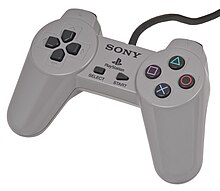PlayStation controller
 | |
| Developer | Sony Computer Entertainment |
|---|---|
| Manufacturer | Sony |
| Type | Video game controller |
| Generation | Fifth generation |
| Release date | 3 December 1994 |
| Discontinued | 1997 |
| Input |
|
| Connectivity | PlayStation controller port |
| Successor | Dual Analog Controller |
The PlayStation controller is the first gamepad released by Sony Computer Entertainment for its PlayStation home video game console. The original version (model SCPH-1010) was released alongside the PlayStation on 3 December 1994.[1]
Design[]
Based on the basic button configuration established with Nintendo's Super NES Controller, the PlayStation controller added a second pair of shoulder buttons for the middle fingers. Intended to update the gamepad for navigating 3D environments such as the ones PlayStation was designed to generate, the concept behind featuring shoulder buttons for both the index and middle fingers was to implement two-way directional depth controls using the two sets of buttons. To compensate for the less stable grip from shifting the middle fingers' placement to the shoulders, grip handles were added to the controller.[2]
Using the simple geometric shapes of a green triangle, a red circle, a blue cross, and a pink square (△ ○ × □) to label its action buttons rather than traditionally used letters or numbers, the PlayStation controller established a trademark which would be incorporated heavily into the PlayStation brand. In an interview with Teiyu Goto, designer of the original PlayStation controller, he explained what the symbols mean: the circle and cross represent "yes" and "no", respectively (which explains their common use as "confirm" and "cancel" in games; this layout is reversed in Western games); the triangle symbolizes a point of view and the square is equated to a sheet of paper there to be used to access menus.[3]
The PlayStation 2 console is backward-compatible with the original PlayStation controller, with limited function due to a lack of analog sticks and pressure sensitive buttons.
History[]
Ken Kutaragi recounted the designing of the controller:
In development, we simulated every possible joypad situation. We imagined what it would be like to have to continually put the pad down while mapping a game, or playing while lying on the floor, and many other cases. After that we had to decide on the weight of the buttons and the pad itself. We adjusted the weights one gram at a time and eventually we found the correct balance. We probably spent as much time on the joypad's development as we did on the body of the machine.[4]
Both Goto and Kutaragi recalled that Sony president Norio Ohga showed a special interest in the development of the controller, and strongly supported the final version.[3]
On April 2, 1996, Sony released a revised version of the PlayStation controller (model SCPH-1080), which is 10% larger than the launch model and features a longer cord with a ferrite bead.[1] This model was bundled with all subsequent PlayStation consoles including North American launch models.
After briefly selling the Dual Analog Controller in 1997, Sony began phasing out the PlayStation controller later that year with the introduction of the DualShock controller, which would become the new standard controller for the PlayStation, although the first game to require its use, Ape Escape, would only be released two years later.[5]
References[]
| Wikimedia Commons has media related to PlayStation Controller. |
- ^ a b Maru-Chang. "SCPH". MiragePalace. Retrieved 2010-06-30.
It's the second type of controller for PlayStation. The cable became long, and the noise filter was added. Other functions are the same as SCPH-1010. 2 April 1996 for ¥2500.
- ^ "An interview with Ken Kutaragi", Next Generation, Burlingame, California: Imagine Publishing, vol. 1, no. 6, p. 53, June 1995, ISSN 1078-9693
- ^ a b All About the PlayStation 1's Design, May 2010, archived from the original on 2011-07-05
- ^ "What's the 'Father of PlayStation' Playing At?". Next Generation. No. 32. Imagine Media. August 1997. p. 10.
- ^ "History of PlayStation 1998". PlayStation Museum. Archived from the original on 2010-01-01. Retrieved 2010-06-30.
A new model of the PlayStation game console went on sale in Japan in November 1997. The new DualShock controller, which is supplied as a standard peripheral, can generate two types of vibrations and allow improved control of the game, adding a new dimension to the realism of video gaming.
- Video game controllers
- PlayStation (console) accessories
